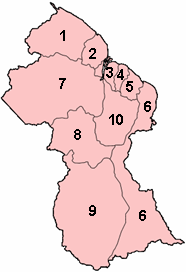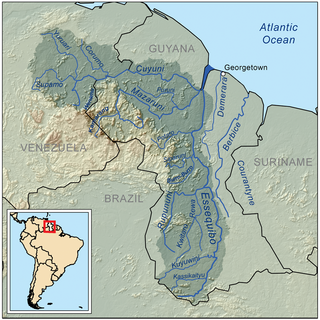
Guyana is divided into 10 regions:

Bartica, Essequibo, is a town on the left bank of the Essequibo River in Cuyuni-Mazaruni, at the confluence of the Cuyuni and Mazaruni Rivers with the Essequibo River in Guyana. It is the regional capital of Cuyuni-Mazaruni.

The Cuyuni River is a South American river and a tributary of the Essequibo River. It rises in the Guiana Highlands of Venezuela, where it descends northward to El Dorado, and turns eastward to meander through the tropical rain forests of the Cuyuni-Mazaruni Region of Guyana. It finally turns southeastward, flowing to its confluence with the Mazaruni River.

Cuyuni-Mazaruni is a region of Guyana. Venezuela claims the territory as part of Guayana Esequiba.

The Mazaruni River is a tributary of the Essequibo River in northern Guyana. Its source is in the remote western forests of the Pakaraima Mountains and its confluence with the Cuyuni River is near Bartica. As it descends from the Guiana Highlands the river runs south-east, past Issano, then northward to Bartica. The river is a source of alluvial gold.

Upper Demerara-Berbice is a region of Guyana, bordering the regions of Essequibo Islands-West Demerara, Demerara-Mahaica and Mahaica-Berbice to the north, the region of East Berbice-Corentyne to the east, and the regions of Potaro-Siparuni and Cuyuni-Mazaruni to the west.

Potaro-Siparuni is a region of Guyana. Venezuela claims the majority of the Region located west of the Essequibo River as part of Guayana Esequiba.

Kamarang is an Amerindian village, standing at the confluence of the Kamarang River and Mazaruni River, in the Cuyuni-Mazaruni Region of Guyana.

Peckoltia is a genus of small South American armored suckermouth catfishes. Many of these fish are popular aquarium fish.
The Kako River is a river in the Cuyuni-Mazaruni region of Guyana and one of the largest tributaries of the Mazaruni River.
Mazarunia is a genus of cichlids from the Mazaruni River, a tributary of the Essequibo River in Guyana. They are dwarf cichlids that do not surpass 8.5 cm (3.3 in) in length.

Peckoltia sabaji is a species of catfish in the family Loricariidae. It is native to South America, where it occurs in the basins of the Rupununi, the Essequibo River, and the Takutu River in Guyana, as well as the basins of the Casiquiare canal, the Rio Negro, the Cinaruco River, and the Orinoco in Venezuela. It is usually found among boulders in medium to large rivers. The species reaches 19.8 cm SL and is of disputed classification.
Issano is a village of Cuyuni-Mazaruni, Guyana. It's located along the Mazaruni River, and is a hub for mining.
Isseneru is an Amerindian settlement in the Cuyuni-Mazaruni region of Guyana, approximately 15–20 miles west of Kurupung.
Paruima is an indigenous village of Pemon Amerindians in the Cuyuni-Mazaruni Region of Guyana. The village was founded as a mission of the Seventh-day Adventist Church. It is the only Pemon speaking community in Guyana.
Neblinichthys brevibracchium is a species of catfish in the family Loricariidae. It is native to South America, where it occurs in the Mazaruni River in the Essequibo River drainage in Guyana. The species reaches 8 cm SL.
Neblinichthys peniculatus is a species of catfish in the family Loricariidae. It is native to South America, where it occurs in the Carapo River, which is part of the Paragua River basin in Venezuela. It is reportedly found in two rapids complexes in the Carapo. The species reaches 8.1 cm SL.
Neblinichthys roraima is a species of catfish in the family Loricariidae. It is native to South America, where it occurs in the Kukenan River basin in the Caroní River drainage in Venezuela. It is known to inhabit creeks devoid of aquatic vegetation with a substrate composed of stones and sand, at an elevation of 1200 to 1400 m. The species reaches 5.1 cm SL.
Pseudancistrus guentheri is a species of catfish in the family Loricariidae. It is native to South America, where it was initially collected from an unknown locality in Guyana, although it has subsequently been reported from the confluence of the Mazaruni River and the Cuyuni River near the village of Kartabo. The species reaches 12 cm (4.7 in) in length.
Hypostomus hemiurus is a species of catfish in the family Loricariidae. It is native to South America, where it occurs in various coastal drainage basins in Guyana, reportedly including the Potaro River, the Mazaruni River, and the Rupununi. The species reaches 20.1 cm in standard length and is believed to be a facultative air-breather.








